Weekly Current Affairs (1st to 7th September 2024) Part - 1 | General Test Preparation for CUET UG - CUET Commerce PDF Download
GS2/Polity
75 Years of Supreme Court
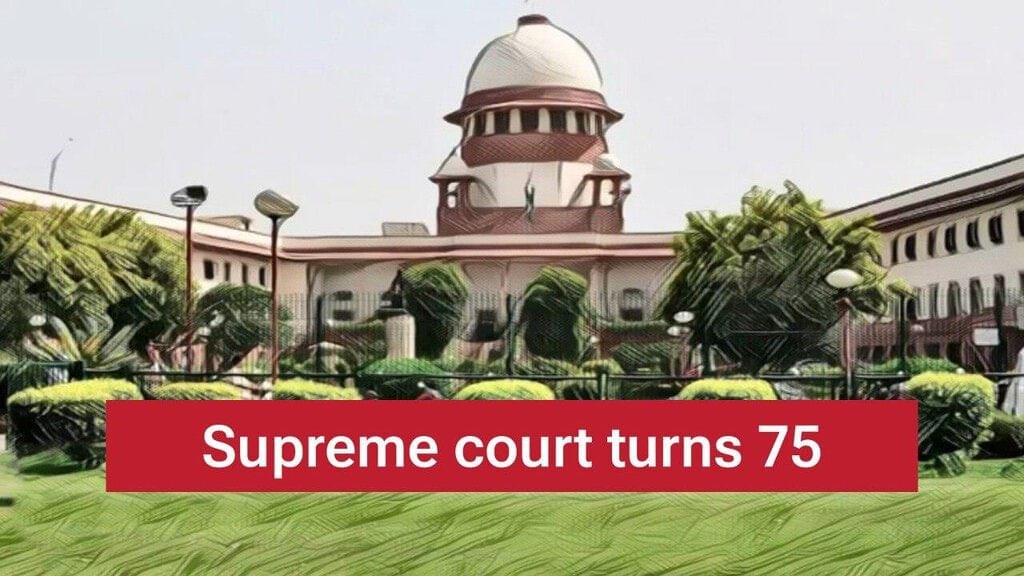
Why in news?
- Recently, the President unveiled a new flag and insignia for the Supreme Court, established on 26 January 1950, to commemorate its 75th anniversary. The flag showcases the Ashoka Chakra, the Supreme Court building, and the Constitution of India. Additionally, the Prime Minister released a commemorative postage stamp celebrating this milestone.
What are the Key Highlights of the Supreme Court’s 75 Years Journey?
- Role of Judiciary in Strengthening Democracy: The Indian judiciary has been pivotal in protecting democracy and upholding liberal values since independence. It serves as a guardian of the Constitution, protecting the rights of marginalized groups and acting as a counter-majoritarian institution.
- Evolution of Supreme Court (SC): The SC's journey in enhancing democracy and safeguarding personal liberties can be categorized into four distinct phases.
First Phase (1950-1967):
- Adherence to Constitutional Text: This period was characterized by a conservative approach, with the judiciary focused on interpreting the Constitution as it was written.
- Judicial Review: Initially, the judiciary exercised judicial review to oversee legislative actions without exceeding its limits.
- Avoidance of Ideological Influence: The SC maintained independence from governmental ideologies, demonstrating this in the Kameshwar Singh case (1952), which ruled against the abolition of zamindari without nullifying parliamentary amendments.
- Respect for Legislative Supremacy: In the Champakam Dorairajan case (1951), the court struck down educational reservations but avoided direct confrontation with Parliament.
Second Phase (1967-1976):
- Judicial Activism: This era marked a shift towards more active judicial involvement and challenges to parliamentary authority.
- Expansion of Fundamental Rights: The Golak Nath judgment (1967) asserted that Parliament could not abridge Fundamental Rights, emphasizing the judiciary's role in protecting these rights.
- Landmark Rulings on Constitutional Amendments: The Keshavananda Bharati case (1973) introduced the 'basic structure' doctrine, limiting Parliament's amendment powers and creating tensions with the executive branch.
- Impact of the Emergency: The 1975 Emergency severely affected judicial independence, exemplified by the ADM Jabalpur case, which upheld the suspension of the right to life under Article 21.
Third Phase (1978-2014):
- Course Correction Post-Emergency: Following the Emergency, the judiciary sought to reclaim its integrity, notably through the Maneka Gandhi case, which broadened interpretations of the right to life.
- Rise of Public Interest Litigation (PIL): The judiciary facilitated access to justice for marginalized communities through PILs, addressing various pressing social issues.
- Collegium System: This system was established to secure judicial independence in appointing judges, later reinforced by striking down the National Judicial Appointments Commission Act, 2014.
Fourth Phase (2014-Present):
- Liberal Interpretation: The SC has taken a liberal approach, such as upholding the revocation of Article 370 in Jammu and Kashmir.
- Sustaining Judicial Activism: The judiciary continues to protect constitutional rights, as seen in its invalidation of the opaque electoral bonds scheme
What are the Key Challenges Facing the Supreme Court of India
- Volume of Pending Cases: As of the end of 2023, the Supreme Court had 80,439 pending cases, causing significant delays in justice delivery.
- Dominance of Special Leave Petitions (SLPs): SLPs represent the majority of cases, limiting the court's capacity to address a broader range of issues.
- Selective Prioritization of Cases: The practice of prioritizing certain cases creates perceptions of favoritism, as seen in the swift handling of high-profile bail applications.
- Judicial Evasion: Backlogs sometimes lead to avoidance of crucial cases, such as the challenges against the Aadhaar scheme.
- Conflict of Interest and Integrity: Allegations of corruption, including those involving retired judges entering politics, threaten public trust.
- Concerns of Appointment of Judges: The appointment process, especially the Collegium system, has faced criticism, prompting discussions for reform.
Way Forward
- All India Judicial Recruitment: Advocating for a national standard in judicial recruitment can enhance consistency and quality across states.
- Case Management Reforms: Implementing advanced management techniques, such as the e-Courts Project, can help reduce backlogs.
- Promote Alternate Dispute Resolution (ADR): Encouraging ADR can help mitigate the case load on the Supreme Court.
- Transparent Case Listing: A public tracking system for case statuses can enhance transparency in prioritization.
- Clarify Institutional Goals: Establishing clear goals through performance evaluation frameworks can realign the court’s objectives.
- Strengthen Accountability Mechanisms: Implementing stricter measures for judges' accountability is essential for maintaining integrity.
Mains Question:
- Discuss the Supreme Court’s 75-year evolution while promoting democracy and personal liberty. Discuss strategies for overcoming current challenges to ensure effective justice?
GS3/Science and Technology
BioE3 Policy and Biotechnology in India
Why in News?
- Recently, the Union Cabinet approved the proposal ‘BioE3 (Biotechnology for Economy, Environment and Employment) Policy for Fostering High-Performance Biomanufacturing’ of the Department of Biotechnology. Alongside the BioE3 Policy, the Union Cabinet also merged three schemes of the Science & Technology Ministry into a single scheme, called Vigyan Dhara, with a financial outlay of Rs 10,579 crore until 2025-26.
What is BioE3 Policy?
About: The BioE3 Policy aims to enhance high-performance biomanufacturing, which focuses on creating bio-based products across various sectors. This policy is in alignment with national goals such as achieving a 'Net Zero' carbon economy and promoting sustainable growth through a circular bioeconomy.
Objectives:
- Encourages innovation in research and development (R&D) and entrepreneurship.
- Establishes Biomanufacturing & Bio-AI hubs and Biofoundries.
- Aims to expand India's skilled biotechnology workforce.
- Aligns with 'Lifestyle for Environment' initiatives.
- Targets the creation of regenerative bioeconomy models.
- Seeks to generate significant employment, especially in tier-II and tier-III cities by establishing biomanufacturing hubs that utilize local biomass.
- Emphasizes ethical biosafety and global regulatory alignment to enhance India's competitiveness in biotechnology.
Core Themes of the BioE3 Policy:
- Bio-Based Chemicals and Enzymes: Focus on developing advanced bio-based chemicals and enzymes to minimize environmental impact.
- Functional Foods and Smart Proteins: Innovations aimed at improving nutrition and food security.
- Precision Biotherapeutics: Advancements in precision medicine and biotherapeutics to enhance healthcare outcomes.
- Climate Resilient Agriculture: Promoting agricultural methods that can withstand climate changes, ensuring food security.
- Carbon Capture and Utilization: Encouraging technologies that efficiently capture and utilize carbon emissions in various sectors.
- Futuristic Marine and Space Research: Expanding research in marine and space biotechnology to explore new biomanufacturing opportunities.
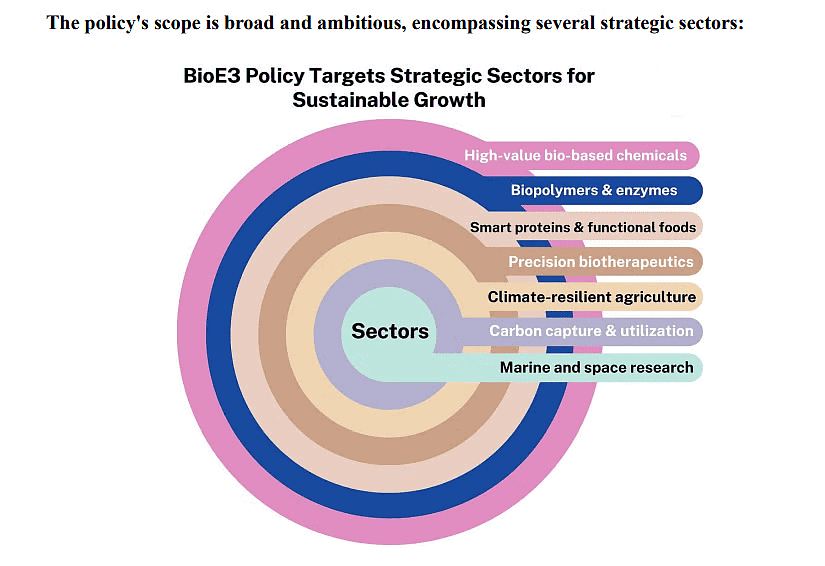
What is the Vigyan Dhara Scheme?
Background:
- The Department of Science & Technology (DST) serves as the primary department for organizing and promoting science, technology, and innovation activities in India. The existing central sector umbrella schemes implemented by DST have been integrated into the unified scheme 'Vigyan Dhara'.
Objectives and Goals:
- The merging of the three schemes into Vigyan Dhara aims to enhance fund utilization and coordination among various sub-schemes and programs.
- Vigyan Dhara seeks to expand the R&D base in India and increase the Full-Time Equivalent (FTE) researcher count.
- It focuses on boosting women's participation in Science, Technology, and Innovation (STI) fields to achieve gender parity.
- All programs under Vigyan Dhara align with the 5-year goals of DST and contribute to the vision of "Viksit Bharat 2047," aiming for a developed India by 2047.
Complementing the BioE3 Policy:
- Enhances S&T institutional infrastructure and develops a critical human resource pool.
- Promotes both basic and translational research in areas like sustainable energy and water.
- Encourages innovations from educational institutions to industry while increasing collaboration between academia, government, and industries.
What is Biotechnology?
Biotechnology merges biology with technology, utilizing cellular and biomolecular processes to create products and technologies that improve lives and protect the environment.
Benefits:
- Healthcare Advancements: Medical Biotechnology (Red Biotech) facilitates the development of advanced drugs, vaccines, and therapies, including personalized medicine and gene therapy. It played a crucial role in the rapid production of vaccines during the Covid-19 pandemic.
- Agricultural Improvements: Agricultural Biotechnology (Green Biotech) involves genetic modification in plants to create crops that resist pests and environmental stresses, hence enhancing food security. For example, Golden Rice is fortified with vitamin A to combat malnutrition.
- Environmental Sustainability: Biotechnology employs microorganisms for bioremediation to clean pollutants such as oil spills and heavy metals, aiding in ecosystem restoration.
- Industrial Biotechnology (White Biotech): Utilizes biotechnology for industrial processes, producing biofuels and biodegradable materials while promoting cleaner production methods.
- Economic Growth: The biotech industry contributes to economic growth by creating jobs in research and manufacturing. Countries investing in biotechnology gain a competitive edge in global markets.
- Climate Change Mitigation: Certain biotechnologies capture carbon dioxide, aiding in climate change mitigation and fostering cleaner biofuel production.
- Innovation in Materials: Biotechnology enables the creation of novel materials, including bio-based fibers and high-performance bio-composites, utilized across various industries.

What is the Current State of Biotechnology in India?
Biotechnology Hub:
- India is among the top 12 global biotechnology destinations. The Covid-19 pandemic accelerated advancements in vaccine and medical device development. In 2021, India registered a record 1,128 biotech startups, reaching a total of 6,756 by 2022, with projections of hitting 10,000 by 2025.
Bioeconomy:
- India's bioeconomy has surged from USD 10 billion in 2014 to over USD 130 billion in 2024, with expectations to reach USD 300 billion by 2030. Biopharma dominates, accounting for 49% of this value, projected at USD 39.4 billion, while the vaccination market is anticipated to reach Rs. 252 billion (USD 3.04 billion) by 2025.
Bioresources:
- India’s rich biodiversity, particularly in the Himalayas and along its 7,500 km coastline, provides a significant advantage in developing biotechnology. The Deep Sea Mission aims to explore marine biodiversity.
Government Initiatives:
- National Biotechnology Development Strategy 2020-25
- National Biopharma Mission
- Biotech-KISAN Scheme
- Atal Jai Anusandhan Biotech Mission
- One Health Consortium
- Biotech Parks
- Biotechnology Industry Research Assistance Council (BIRAC)
- Genome India Project
Recent R&D Achievements in Applied Biotechnology:
- ADVIKA Chickpea Variety: Developed a drought-tolerant variety with improved seed weight and yield under drought conditions.
- Accel Breed Facility: A cutting-edge speed breeding facility at Punjab Agricultural University (PAU), Ludhiana, accelerates crop improvement programs.
- Indigenous Vaccines: India has developed notable vaccines including the quadrivalent Human Papilloma Virus (qHPV) vaccine and ZyCoV-D (DNA vaccine), along with GEMCOVAC-OM, an mRNA-based Omicron booster.
- Gene Therapy: India has approved its first gene therapy clinical trial for Hemophilia A.
- Novel Blood Bag Technology: Researchers at inStem, Bengaluru, have created protective sheets for stored red blood cells to enhance transfusion safety.
Future Outlook:
- The biotechnology sector is expected to grow to USD 150 billion by 2025 and may reach USD 300 billion by 2030.
- This industry is projected to contribute around 3.3-3.5% to India’s Gross Domestic Product (GDP).
- The market for diagnostics and medical devices is anticipated to expand significantly, with the therapeutics sector expected to generate USD 15 billion in bioeconomic activity by 2025.
- Growth is likely to be driven by the expansion of biotech incubators and support for startups across health, agriculture, and industrial sectors.
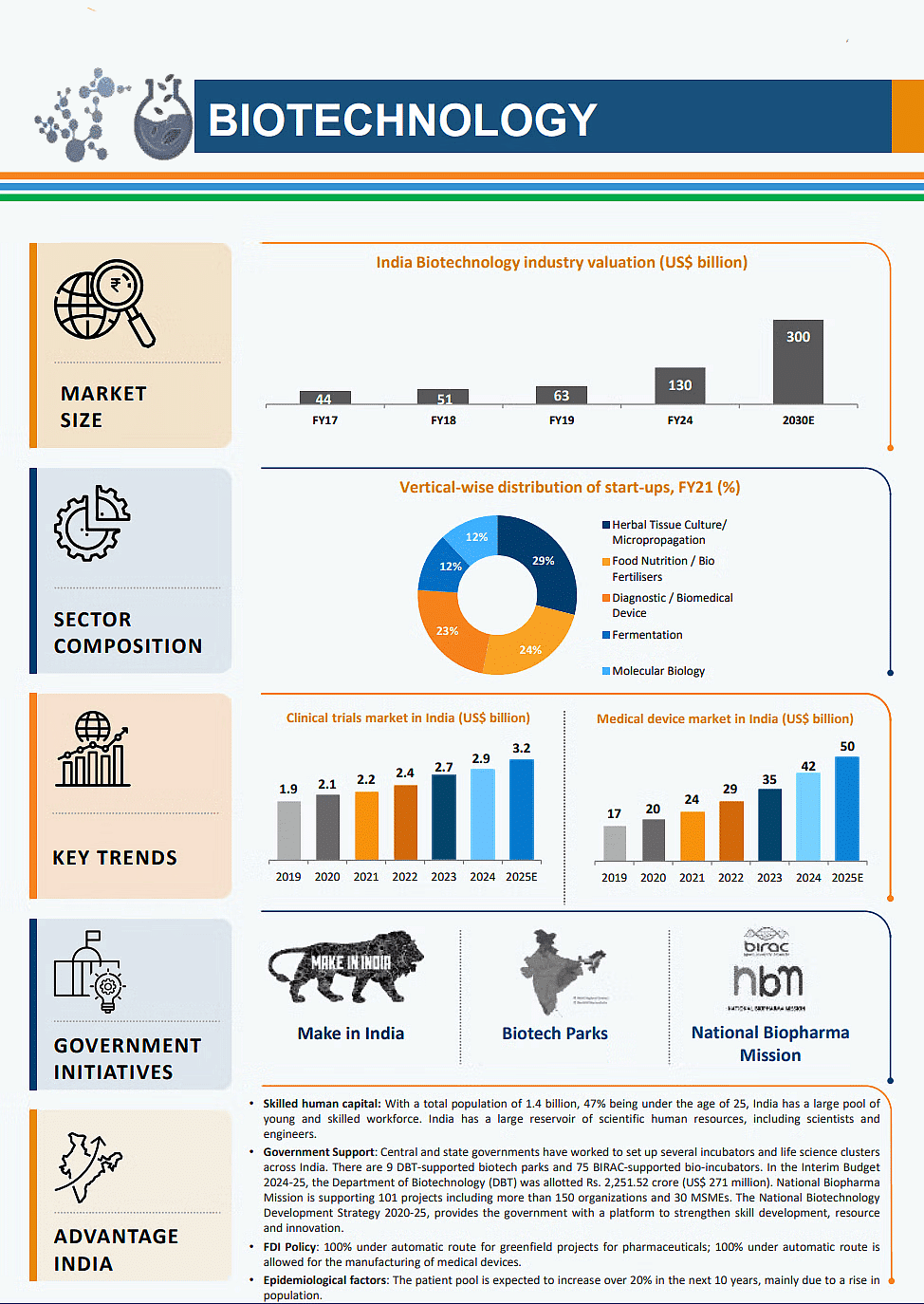
What are the Challenges for Biotechnology in India?
- Strategic Roadmap Development: There is a lack of an overarching strategic plan for biotechnology that outlines competitive areas and industry-specific R&D needs. Significant advancements in crop improvement and therapeutics require a revolution akin to the White Revolution.
- Bio-Networking: Effective networking is essential to enhance collaboration among biotechnology firms, address intellectual property rights, and ensure biosafety and bioethics.
- Human Resources: There is a shortage of specialized human resources in biotechnology, especially in remote areas.
- Regulatory Burden: The regulatory environment for biotechnology in India is complex and slow, particularly for genetically modified organisms (GMOs). The approval process involves multiple agencies, leading to delays.
- Funding and Investment: Although government funding exists under the Biotechnology Industry Partnership Programme (BIPP), additional investment is vital for supporting high-risk, innovative research projects.
- IT Integration and Data Management: Extensive IT support is needed for data management in biotechnology research, including challenges in data integration and establishing technical standards.
Way Forward
- Expand training initiatives like the Biotech Industrial Training Programme (BITP) to cultivate a skilled workforce in biotechnology.
- Encourage venture capital investments in biotech startups and early-stage companies.
- Promote public-private partnerships to mobilize resources and accelerate innovation.
- Formulate and implement supportive policies focusing on regulatory streamlining, tax benefits, and subsidies to attract and retain biotech firms.
- Leverage initiatives such as the Production Linked Incentive (PLI) scheme to enhance competitiveness.
- Build global market presence and brand recognition through strategic partnerships and investments.
- Engage actively in global biotechnology initiatives like the Global Alliance for Genomics and Health and the International Association of Plant Biotechnology (IAPB).
- Support the export of biotechnology products and services to international markets.
Mains Question:
Q. Discuss the BioE3 Policy, its alignment with India's national goals, and how biotechnology has evolved in India. Suggest potential solutions to address challenges.
GS3/Science and Technology
Repairability Index for Mobile and Electronic Sectors
 Why in news?
Why in news?
- Recently, the Department of Consumer Affairs (DoCA) under the Ministry of Consumer Affairs, Food & Public Distribution organized a National Workshop focused on the Right to Repair Framework for the Mobile and Electronic Sectors. The workshop aimed at launching a “Repairability Index” for mobile phones and electronic products, designed to assist consumers in making informed purchasing decisions. This initiative seeks to tackle the escalating issue of e-waste and promote the production of items that are easier to repair.
Objective of the Workshop:
- The workshop aimed to establish a consensus among industry stakeholders regarding a repairability index.
- Focus on enhancing product longevity and making repair information accessible to improve consumer experiences with mobile and electronic products.
- Helps mitigate the need for consumers to purchase new products due to limited repair options or high repair costs.
Addressing Planned Obsolescence:
- Discussions highlighted the issue of "planned obsolescence," where manufacturers limit access to essential repair information and spare parts.
- This creates a scenario where consumers are forced to abandon devices or seek counterfeit parts from unofficial markets.
International Best Practices:
- Sessions underscored the need to incorporate global best practices from countries like France, the European Union, and the United Kingdom.
- Stressed the importance of sustainable product design and transitioning from a "use and dispose" model to a "circular economy."
Key Facts about the Repairability Index:
- Definition: The repairability index is a mandatory label that manufacturers will attach to electrical and electronic equipment, indicating the product's repairability.
- Criteria for Rating Products:
- Availability of Technical Documents: Access to manuals and guides that aid in repairs.
- Ease of Disassembly: The simplicity of taking apart a product to access and repair components.
- Availability and Pricing of Spare Parts: The readiness of spare parts and their affordability for consumers.
- Scoring System: Products will receive scores on a scale from 1 to 5.
- Score of 1: Indicates a high risk of damage, requiring disassembly of multiple components for access.
- Score of 5: Represents easy repairability, allowing direct access to critical parts like batteries without unnecessary disassembly.
What is the Right to Repair?
About:
- The right to repair allows consumers and businesses to repair their own devices without restrictions imposed by manufacturers.
Features of the Right to Repair:
- Access to Information: Consumers should receive repair manuals, schematics, and software updates.
- Availability of Parts and Tools: Third parties should have access to necessary parts and tools for repairs.
- Legal Unlocking: Consumers should be permitted to unlock or modify devices, such as installing custom software.
- Repair-Friendly Design: Devices should be engineered for easy repairs.
Need for the Right to Repair:
- Growing E-Waste: The difficulties in repairing devices lead to increased electronic waste, with India contributing significantly to global e-waste.
- Monopoly of Repairs: Manufacturers often create barriers to third-party repairs, limiting consumer choices and driving up costs.
- Sustainability: Promoting repairability contributes to achieving circular economy goals by extending the lifespan of products.
Initiatives for the Right to Repair:
Right to Repair in India
- A committee led by Nidhi Khare has developed the Right to Repair Portal India, providing centralized information on product repair and maintenance.
- 63 companies, including 23 from the mobile and electronics sector, have joined this portal to offer information on repair options and spare parts.
Right to Repair in Other Countries
- United States: The Fair Repair Act of 2022 mandates companies to provide tools and eliminate software restrictions for repairs.
- European Union: The Right to Repair Rules 2019 give users access to repair tools for consumer appliances.
- United Kingdom: Regulations ensure spare parts are available for up to ten years post-product release.
- Australia: Volunteer repairmen assist in “Repair Cafes,” sharing repair skills with the community.
Challenges in Implementing the Right to Repair:
- Opposition from Tech Companies: Major companies argue that the right to repair could jeopardize security, intellectual property, and product quality.
- Shrinking Technology: As technology becomes more compact, repairs demand specialized tools not readily available to the average consumer.
- No Incentive to Innovate: Manufacturers prefer pushing new technology over repairs, fearing it may reduce innovation.
- Efficiency Concerns: Enhancing repairability may compromise the efficiency of modern devices.
- Security and Privacy Risks: Allowing third-party access might lead to breaches of user data.
Way Forward:
- Fair Access to Repair Tools: Manufacturers should be encouraged to make repair manuals and diagnostic tools more accessible to independent repair shops.
- Balancing Efficiency and Repairability: A balanced approach in design can enhance both efficiency and repairability through modular components.
- Incentivizing Innovation: Governments could provide incentives for companies investing in both innovative and repairable designs.
Mains Question:
Q. Discuss the concept of the 'Right to Repair' and its implications for consumer rights, environmental sustainability, and innovation.
GS2/International Relations
The Religious Composition of the World’s Migrants Report
Why in news?
- Recently, the Pew Research Center released a report based on data from the United Nations and 270 censuses and surveys, highlighting that over 280 million people, or 3.6% of the global population, were international migrants in 2020. The report emphasizes the significant influence of religion on migration patterns, affecting both the departure from one's homeland and the reception in the destination country.
What are the Key Findings of the Report?
Trend among Hindu Migrants:
- In 2020, India was identified as the leading country for both emigrants and immigrants, with 7.6 million Hindus born in India living abroad.
- Approximately 3 million Hindus born in other countries were residing in India.
Trend among Christians:
- Christians make up the largest segment of the global migrant population, accounting for 47%.
Migration Trends among Religious Minorities in India:
- Religious minorities represent a disproportionate number of Indian emigrants, comprising 16% of emigrants but only 2% of India's population.
- Muslims account for 33% of all Indian-born migrants, despite being only 15% of India’s population, with 6 million Muslims emigrating, primarily to the UAE, Saudi Arabia, and Oman.
Trend among GCC Countries:
- The migrant population in Gulf Cooperation Council (GCC) countries has surged by 277% since 1990.
- 75% of the GCC migrant population consists of workers from various countries, with Hindus and Christians making up 11% and 14%, respectively.
- As of 2020, GCC countries host 9.9 million Indian migrants.
Trends in Global Migration:
- From 1990 to 2020, the number of international migrants increased by 83%, significantly surpassing the 47% growth of the global population.
- Migrants typically travel an average distance of 2,200 miles.
Religious Alignment and Migration Patterns:
- Individuals often migrate to countries where their religious beliefs align with those of the local population, driven by cultural and religious familiarity, which aids in the integration process.
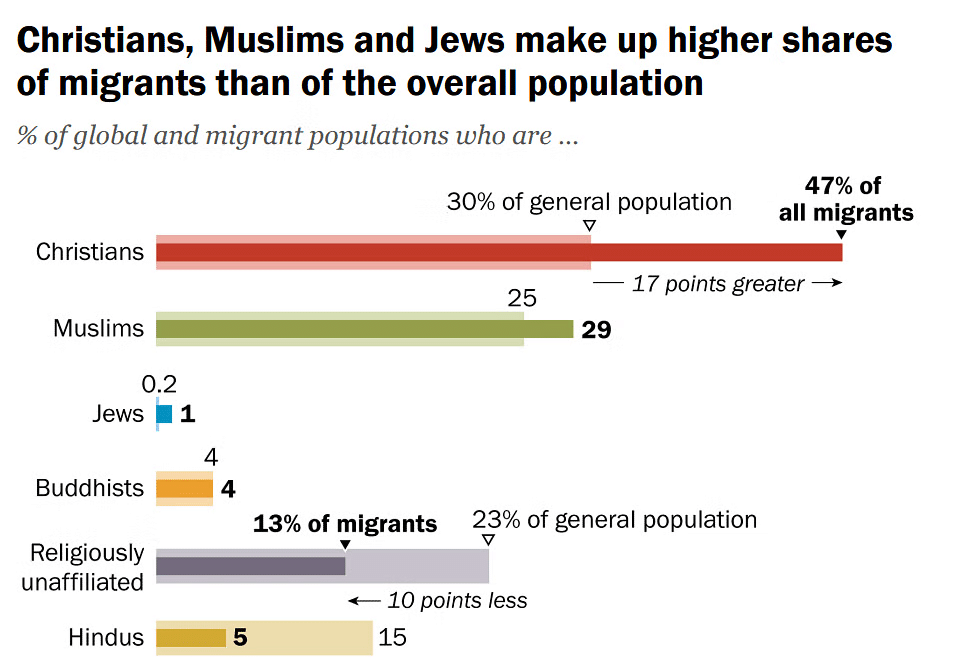
What is Hindu Migration Pattern and Trends?
Global Underrepresentation:
- Hindus constitute only 5% of all international migrants, with 13 million Hindus living outside India, which is notably lower than their global population share of 15%.
Distance Travelled:
- Hindu migrants tend to travel longer distances, averaging 3,100 miles from their home countries, compared to the global average of 2,200 miles for all migrants.
- This represents the longest average distance traveled by any religious group originating from Asia.
Regions of Destination for Hindu Migrants:
- The Asia-Pacific region hosts the largest share of Hindu migrants (44%), followed by the Middle East-North Africa (24%), North America (22%), and Europe (8%). Very few Hindus reside in Latin America or sub-Saharan Africa.
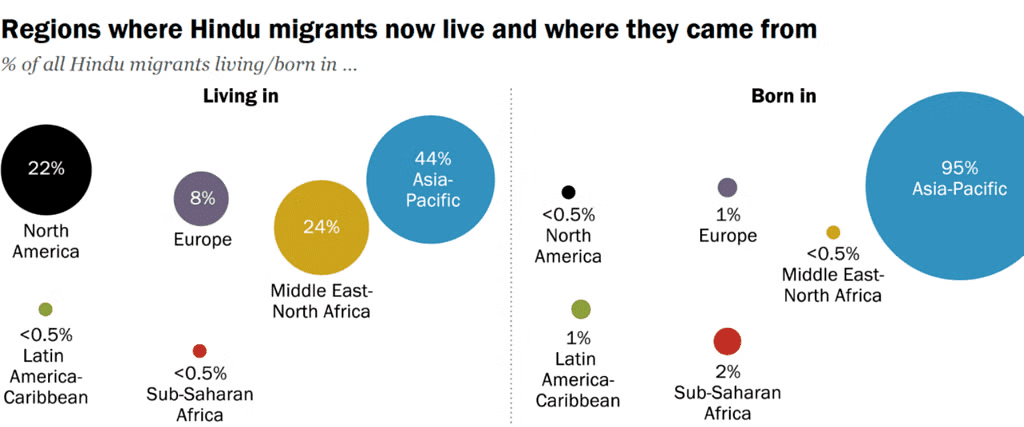
Regions of Origin for Hindu Migrants:
- A significant majority (95%) of Hindu migrants originate from India, which alone accounts for 57% of the world’s Hindu migrants and is home to 94% of the global Hindu population.
- Other notable sources of Hindu migrants include Bangladesh (12%) and Nepal (11%).
India as Destination for Hindu Migrants:
- India serves as a key destination for Hindu migrants, hosting 22% (3 million) of all Hindu migrants, a trend largely influenced by historical events like the partition of British India in 1947 and subsequent persecutions in Pakistan and Bangladesh.
Notable Country Pairs for Hindu Migration:
- India to the United States: This is the most common migration route for Hindus, with 1.8 million Hindus migrating to the US, often in pursuit of better employment and educational opportunities.
- Bangladesh to India: The second most frequent route involves 1.6 million Hindus moving to India, motivated by historical, social, and economic factors.
How Diaspora Communities Boost Home-Country Growth?
Substantial Financial Inflows:
- Diverse diaspora communities play a crucial role in their home countries' economies by sending remittances. In 2022, migrants from emerging and developing countries sent USD 430 billion, which is three times more than what these nations receive in foreign aid.
Impact on GDP:
- Remittances significantly contribute to the Gross Domestic Product (GDP) of various countries, accounting for 37% in Tajikistan, 30% in Nepal, and about 25% in Tonga, Liberia, and Haiti.
Diaspora Investments:
- Diaspora communities frequently invest in businesses and government bonds in their home countries, which helps to increase financial capital.
Knowledge Transfer and Expertise:
- Diaspora members transfer valuable knowledge and expertise acquired abroad back to their home nations, enhancing productivity by improving education quality and fostering better business and governance practices.
Bridging Knowledge Gaps:
- Members of the diaspora utilize their skills, global networks, and understanding of local customs to assist home-country businesses in overcoming challenges, improving efficiency, and expanding into new markets. For example, Indian executives working in US technology companies have facilitated outsourcing efforts to India.
Conclusion
Migration and diaspora communities significantly boost the economic growth of their home countries through remittances, investments, and knowledge transfer. To maximize these benefits, governments should establish strong diaspora networks, reduce barriers to investment, lower remittance costs, and support diaspora-led initiatives. These strategies will enhance capital inflow, productivity, and sustainable development.
Mains Question:
Q. Discuss how migration and diaspora communities contribute to the economic growth and development of their home countries.
GS2/Governance
DICGC Overcharging Commercial Banks

Why in news?
- The Deposit Insurance and Credit Guarantee Corporation (DICGC), a subsidiary of the Reserve Bank of India (RBI), is currently facing scrutiny regarding its premium structure. This structure appears to overcharge commercial banks while disproportionately benefiting cooperative banks. Such disparities have raised concerns about the fairness and efficiency of the existing system, leading to calls for a reevaluation of the premiums based on the risk profiles of various banking institutions.
How are the Commercial Banks Being Overcharged for Deposit Insurance?
- Disproportionate Premium Burden: The DICGC collects 94% of premiums from commercial banks, which only account for 1.3% of net claims. In contrast, cooperative banks contribute just 6% of premiums yet claim 98.7% of net claims. Since its inception in 1962, commercial banks have filed gross claims amounting to Rs 295.85 crore, with net claims totaling Rs 138.31 crore. Conversely, cooperative banks have filed gross claims of Rs 14,735.25 crore, with net claims of Rs 10,133 crore. This indicates that well-managed commercial banks are effectively subsidizing the higher risk associated with cooperative banks, which require a significant portion of claims.
Implications for Overcharging Commercial Banks:
- High Compliance Costs: The uniform premium rate of 12 paise per Rs 100 insured, irrespective of risk profiles, imposes high compliance costs on commercial banks. This can adversely affect their operational efficiency and profitability, ultimately impacting their ability to lend and serve customers effectively.
- Inequitable Risk Assessment: Commercial banks, typically having lower risk profiles, are penalized through higher premiums. This undermines the principles of risk evaluation that should guide insurance pricing.
- Impact on Financial Stability: Elevated premiums can lead to reduced financial stability for commercial banks, as they may need to pass on these costs to depositors and borrowers. This could result in higher interest rates for loans and lower returns for depositors, adversely affecting the overall banking ecosystem.
- Encouragement of Poor Management Practices: By making commercial banks bear the costs associated with cooperative bank failures, the current structure may inadvertently encourage poor management practices within cooperative banks, as the consequences of defaults are shifted to more stable institutions.
What are the Key Facts About DICGC?
About:
- Established in 1978, the DICGC was formed following the merger of the Deposit Insurance Corporation (DIC) and the Credit Guarantee Corporation of India Ltd. (CGCI). It operates under the Deposit Insurance and Credit Guarantee Corporation Act, 1961, passed by Parliament, and serves as a deposit insurance and credit guarantee provider for banks in India. It is a fully-owned subsidiary of the Reserve Bank of India (RBI).
Funds Managed by DICGC:
- Deposit Insurance Fund: This fund provides insurance to bank depositors in the event that a bank fails financially and cannot pay its depositors, leading to liquidation. It is funded by premiums collected from banks.
- Credit Guarantee Fund: This fund guarantees specific remedies to creditors if their debtors fail to repay their debts.
- General Fund: This fund covers the operational expenses of the DICGC, including any surplus from its operations.
What is the Deposit Insurance Scheme of DICGC?
- Limit for Deposit Insurance: Currently, depositors are entitled to a maximum claim of Rs 5 lakh per account as insurance coverage. This is termed 'deposit insurance.' Depositors with amounts exceeding Rs 5 lakh have no legal recourse to recover funds in the event of a bank collapse. The insurance premium has been increased from 10 paise for every Rs 100 deposited to a limit of 15 paise.
- The insurance premium is paid by banks to the DICGC and cannot be passed on to depositors. Insured banks are required to pay advance insurance premiums to the corporation semi-annually, based on their deposits at the end of the previous half-year.
- Coverage: This includes regional rural banks, local area banks, and foreign banks with branches in India, all of which are mandated to obtain deposit insurance cover from the DICGC. However, primary cooperative societies are not insured by the DICGC.
Types of Deposits Covered: The DICGC insures all bank deposits, including savings, fixed, current, and recurring deposits, with the exception of:
- Deposits of foreign governments.
- Deposits of Central and State governments.
- Inter-bank deposits.
- Deposits of the State Land Development Banks with State cooperative banks.
- Any amounts due on deposits received from outside India.
- Any amount specifically exempted by the corporation with prior approval.
- Need for Deposit Insurance: Recent cases such as the Punjab & Maharashtra Co-operative (PMC) Bank, Yes Bank, and Lakshmi Vilas Bank have highlighted issues faced by depositors in accessing their funds, underscoring the importance of deposit insurance.
Why is there a Need to Reevaluate Deposit Insurance Premiums by DICGC?
Proposal:
- There are proposals to lower the premium for commercial banks from 12 paise to 3 paise per Rs 100 insured, which could relieve these banks of approximately Rs 20,000 crore in FY26. Conversely, premiums for cooperative banks could remain at 12 paise or increase to 15 paise.
Benefits:
- Risk-Based Premiums: Aligning premiums with the risk profiles of banks would convey that insurance costs should accurately reflect actual risk.
- Economic Efficiency: Lower compliance costs for commercial banks could enhance their operational efficiency, benefiting depositors in the long run.
- Encouraging Good Management: By not penalizing well-managed banks, the system promotes better banking practices.
Mains Question:
Q. Discuss the significance of deposit insurance in the banking sector and the challenges faced by the DICGC in India.
|
164 videos|628 docs|1133 tests
|
















